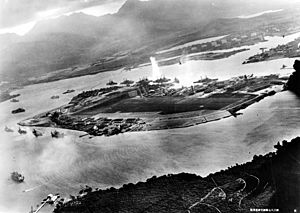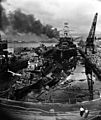Attack on Pearl Harbor facts for kids
Quick facts for kids Attack on Pearl Harbor |
|||||||
|---|---|---|---|---|---|---|---|
| Part of the Pacific Theater of World War II | |||||||
 Photograph from a Japanese plane of Battleship Row at the beginning of the attack. The explosion in the center is a torpedo strike on the USS Oklahoma. Two attacking Japanese planes can be seen: one over the USS Neosho and one over the Naval Yard. |
|||||||
|
|||||||
| Belligerents | |||||||
| Commanders and leaders | |||||||
| Strength | |||||||
| 8 battleships, 8 cruisers, 30 destroyers, 4 submarines, 49 other ships, ~390 aircraft |
Mobile Unit: 6 aircraft carriers, 2 battleships, 2 heavy cruisers, 1 light cruiser, 9 destroyers, 8 tankers, 23 fleet submarines, 5 midget submarines, 414 aircraft |
||||||
| Casualties and losses | |||||||
| 4 battleships sunk, 4 battleships damaged including 1 run aground 2 destroyers sunk, 1 damaged 1 other ship sunk, 3 damaged 3 cruisers damaged 188 aircraft destroyed 155 aircraft damaged, 2,335 military killed 1,247 military wounded 68 civilians killed 35 civilians wounded |
4 midget submarines sunk, 1 midget submarine run aground, 29 aircraft destroyed, 55 airmen killed 9 submariners killed 1 submariner captured |
||||||
The Attack on Pearl Harbor was a surprise attack by Japan against the United States naval base at Pearl Harbor, Hawaii. It happened on the morning of December 7, 1941. This attack caused the United States to join World War II.
Japan was planning to expand its power in Southeast Asia. This included fighting against Britain, the Netherlands, and the U.S. in the Philippines. These countries had stopped selling important supplies like oil to Japan. Japan needed these supplies for its war with China, called the Second Sino-Japanese War. Japan attacked Pearl Harbor to stop the U.S. Pacific Fleet from getting involved in their plans. The Pacific Fleet was a large group of U.S. Navy ships.
The attack involved two waves of planes, with 353 aircraft in total. These planes were launched from six Japanese aircraft carriers. Admiral Isoroku Yamamoto was the commander of the Japanese forces. In total, 2,390 people died during the attack.
All eight American battleships in the harbor were hit. Some were sunk, and others were badly damaged. The USS Arizona (BB-39) exploded. Luckily, the three American aircraft carriers (Enterprise, Lexington, and Saratoga) were not at Pearl Harbor that day. Many U.S. aircraft were destroyed, and some buildings on land were slightly damaged. Japan declared war on the United States on the same day.
Contents
What Happened After the Attack?
The day after the attack, U.S. President Franklin D. Roosevelt spoke to Congress. He famously said that December 7 was "a date which will live in infamy." Most Americans listened to his speech on the radio.
The United States Declares War
Minutes after President Roosevelt's speech, Congress voted to declare war on Japan. Only one member of Congress, Jeanette Rankin, voted "no." Three days later, Germany and Italy also declared war on the United States. This officially brought the U.S. into World War II.
Impact on Americans at Home
After the attack, some people spread rumors. They wrongly blamed Italian, German, and Japanese Americans for knowing about the attack or even helping. Because Germany and Italy were allies with Japan, many Americans became afraid of people with Italian, German, or Japanese heritage.
As a result, starting in 1942, about 110,000 Japanese Americans, 31,000 German Americans, and 3,000 Italian Americans were sent to special camps. These were called internment camps. For example, the father of famous baseball player Joe DiMaggio had to move from the West Coast because he was an Italian immigrant. Some people stayed in these camps until 1944. The U.S. government apologized to Japanese Americans for this in 1988. German Americans and Italian Americans have not received an apology.
After World War II ended, some Japanese leaders who ordered the attack were put on trial. They were charged with war crimes.
See Also
Images for kids
-
Pearl Harbor on October 30, 1941, looking southwest. Ford Island is at its center.
-
An Imperial Japanese Navy Mitsubishi A6M Zero fighter on the aircraft carrier Akagi
-
The Japanese attacked in two waves. The first wave was detected by United States Army radar at 136 nautical miles (252 km), but was misidentified as United States Army Air Forces bombers arriving from the American mainland. Top: A: Ford Island NAS. B: Hickam Field. C: Bellows Field. D: Wheeler Field. E: Kaneohe NAS. F: Ewa MCAS. R-1: Opana Radar Station. R-2: Kawailoa RS. R-3: Kaaawa RS. G: Kahuku. H: Haleiwa. I: Wahiawa. J: Kaneohe. K: Honolulu. 0: B-17s from mainland. 1: First strike group. 1-1: Level bombers. 1–2: Torpedo bombers. 1–3: Dive bombers. 2: Second strike group. 2-1: Level bombers. 2-1F: Fighters. 2-2: Dive bombers. Bottom: A: Wake Island. B: Midway Islands. C: Johnston Island. D: Hawaii. D-1: Oahu. 1: Lexington. 2: Enterprise. 3: First Air Fleet.
-
Captain Homer N. Wallin (center) supervises salvage operations aboard USS California, early 1942
See also
 In Spanish: Ataque a Pearl Harbor para niños
In Spanish: Ataque a Pearl Harbor para niños











